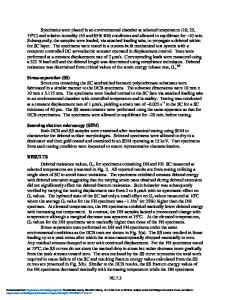Effect of SiC content and interlayer difference on microstructural characterization and mechanical properties of functio
- PDF / 5,447,500 Bytes
- 14 Pages / 595.276 x 790.866 pts Page_size
- 47 Downloads / 343 Views
Effect of SiC content and interlayer difference on microstructural characterization and mechanical properties of functionally graded 6061Al/SiCp composites Tong Wu1,2 · Yong Hu1,2 · Shunbo Wang1,2 · Yuelun Leng1,2 · Maosen Wang3 Received: 5 January 2020 / Accepted: 23 July 2020 © Springer-Verlag GmbH Germany, part of Springer Nature 2020
Abstract Metal matrix composite reinforced gradiently by ceramic phase is a new type of high-tech material with broad application prospects, and the study of the effect of SiC content and interlayer difference on functionally graded materials (FGMs) is vital for the guiding significance of the practical application. Functionally graded 6061Al/SiCp composites (6061Al/SiCp FGMs) were prepared by hot pressing sintering herein, and mechanical properties were evaluated by tensile tests conducted under different temperatures. 6061Al/SiCp FGMs were observed under optical microscopy to identify the particle distribution and transition status between layers, and fracture surfaces were observed to verify the detailed fracture mechanisms. Results show that 6061Al/SiCp FGMs achieving high relative densities of more than 0.99 satisfy requirements of microstructure. When the interlayer difference is consistent, the tensile strength of FGMs increases as the SiC content increases in each layer constituting FGMs, and FGMs have the highest tensile strength at room temperature. The elongation of FGMs decreases as the SiC content increases in each layer constituting FGMs, and FGMs have the highest elongation at 100 °C. When the intermediate layer is consistent, the tensile strength of FGMs with a lower interlayer difference is better, which can be attributed to the interaction of elongation and dislocation. Keywords 6061Al/SiCp FGMs · Interlayer difference · Microstructure · Relative density · Tensile property
1 Introduction * Maosen Wang [email protected] Tong Wu [email protected] Yong Hu [email protected] Shunbo Wang [email protected] Yuelun Leng [email protected] 1
School of Mechanical and Aerospace Engineering, Jilin University, Nanling campus, No. 5988, Ren‑min Street, Changchun 130025, China
2
Key Laboratory of CNC Equipment Reliability, Ministry of Education, Jilin University, Nanling campus, No. 5988, Ren‑min Street, Changchun 130025, China
3
School of Construction Engineering, Jilin University, Chaoyang campus, No. 938, West‑Democracy Street, Changchun 130012, China
Functionally graded materials (FGMs) are important for a wide range of industrial and scientific fields such as electronics, automobiles, national defense industries, aerospace, and nuclear energy [1–7]. FGMs as inhomogeneous composites not only inherit the complementary advantages of compositions and the designability of microstructures of traditional composites but also introduce the gradient design idea of structure and function, which have attracted considerable attention and research interest in the material industry. The FGM includes at least two phases, which generally refers to the matri
Data Loading...










